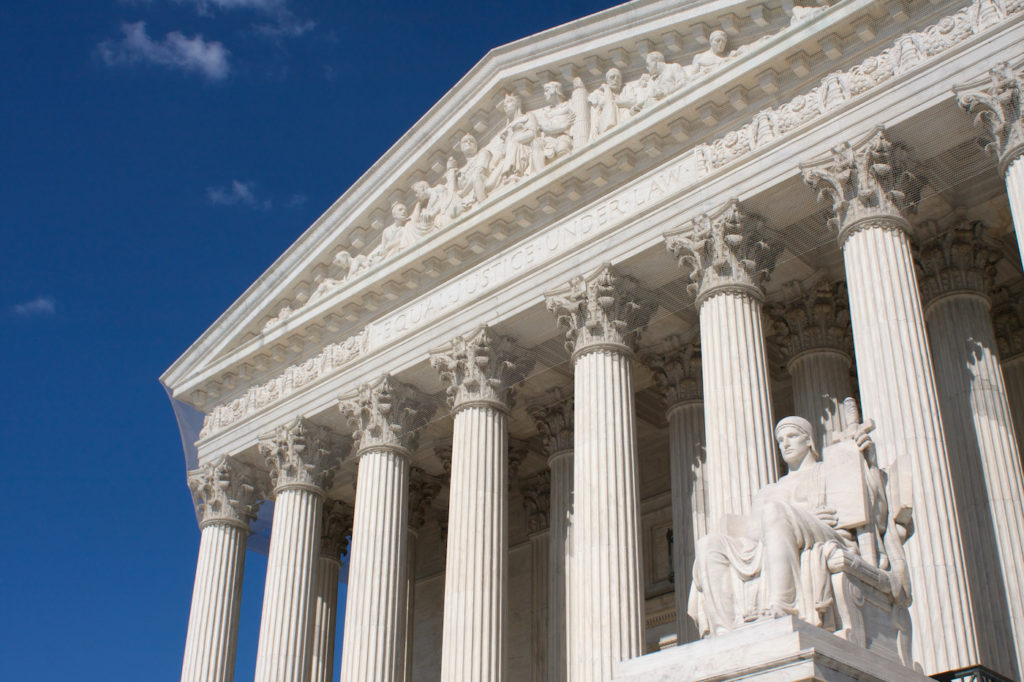In the annals of Supreme Court history, there are surprisingly few truly “great” cases—hugely significant, magnificently correct, principled, courageous decisions vindicating the Constitution. One thinks, of course, of Brown v. Board of Education, the 1954 decision unanimously repudiating Plessy v. Ferguson’s longstanding but atrocious constitutional doctrine of “separate but equal” that endorsed racial apartheid. Brown restored the Constitution’s original meaning of equal protection of the laws—that government may not classify, segregate, or discriminate among classes of citizens on the basis of race, ever. Brown rejected segregation, launched the civil rights era, and transformed American society.
Almost equally magnificent is Youngstown Sheet & Tube Co. v. Sawyer, the Court’s 1952 decision invalidating President Harry Truman’s unconstitutional seizure of the nation’s steel mills during the Korean War. Youngstown vindicated the fundamental principle that the President, even during time of war, is not a dictator or lawmaker, but is instead constrained by the rule of law. The significance of that holding can be measured by the consequences had the decision gone the other way. Imagine if, since 1952, American presidents had been conceded the power to impose binding legal commands affecting private rights, by simple executive decree. Yet the case presented that risk. The 6–3 majority rose to the challenge and ruled against the President, setting a vital, correct, and enduring precedent.
Then there’s West Virginia State Board of Education v. Barnette, the Court’s inspirational 1943 decision upholding the right of public schoolchildren not to be compelled, on pain of expulsion, to salute the flag or recite the Pledge of Allegiance against their religious beliefs and consciences. Barnette, like Brown, overruled a prior atrocious precedent that had betrayed the Constitution (Minersville School District v. Gobitis, decided 8–1 in 1940). The Court vindicated, in spectacular fashion, the fundamental constitutional rights to dissent, freedom of expression, and freedom from government-compelled affirmation. It is difficult to imagine modern America without Barnette’s repudiation of Gobitis. Barnette is arguably the greatest First Amendment decision of the Supreme Court of all time.
Brown, Youngstown, and Barnette rank among the few, true, great Supreme Court decisions of our nation’s history. Some early decisions of the Marshall Court, like McCulloch v. Maryland (1819), are foundational and important, but involved no heroic bravery or contested restoration of constitutional principle. There have been other crucial, correct cases through the years. (One thinks of The Prize Cases, the Court’s important 1863 decision upholding Lincoln’s exercise of Commander-in-Chief powers during the Civil War, presaging the lawfulness of the Emancipation Proclamation.)
But such moments of Supreme Court greatness are truly rare. It is far easier to tick off, rapidly, a list of the Supreme Court’s truly horrific, atrocious decisions—Dred Scott (1857), Bradwell v. Illinois (1873), Plessy (1896), Giles v. Harris (1903), Lochner v. New York (1905), Berea College v. Kentucky (1908), Debs v. United States (1919), Buck v. Bell (1927), Korematsu v. United States (1944), Roe v. Wade (1973), Planned Parenthood v. Casey (1992) and many more—than to identify moments of extraordinary Supreme Court courage, conviction, and correctness in vindicating the Constitution and rescuing our nation’s fundamental law from those who would betray it, including prior generations of judicial Judases. (It is instructive that some of the Court’s greatest decisions involved overruling some of its worst decisions.)
Start your day with Public Discourse
Sign up and get our daily essays sent straight to your inbox.The Greatest Supreme Court Decision of All Time?
Enter Dobbs v. Jackson Women’s Health Organization, decided by the Supreme Court Friday. Dobbs overruled Roe v. Wade’s constitutionally indefensible and morally atrocious creation of a nonexistent constitutional right to abortion of the life of a human fetus throughout pregnancy—a “constitutional right” of some human beings to kill other human beings (to describe the holding of Roe bluntly but not unfairly). Dobbs overruled Planned Parenthood v. Casey’s even more pernicious decision reaffirming Roe not on the basis that it was right but on the basis of a perverted version of the judicial doctrine of “stare decisis” and the Court’s desire to preserve its imagined image of infallibility, supremacy, and prestige.
Dobbs overruled Roe v. Wade’s constitutionally indefensible and morally atrocious creation of a nonexistent constitutional right to abortion of the life of a human fetus throughout pregnancy.
Though we are too close to the Dobbs decision to evaluate it truly dispassionately, and though the decision’s full potential consequences have not yet been achieved (and may never be), it remains possible to make an immediate judgment: Dobbs may be the most important, magnificent, rightly decided Supreme Court case of all time. It is as important as Brown v. Board of Education. It is as fundamental to the Constitution as Youngstown Sheet & Tube. It is as beautiful, in its own way, as Barnette. It is restorative of constitutional principle. It upholds the values of representative, democratic self-government, and the rule of law, at the same time that it supports the protection of fundamental human rights. It is literally a matter of life and death. It is potentially transformative of American society, for the better. It is a rare act of judicial courage and principle. In every way, Dobbs is a truly great decision.
Dobbs’s Significance and Magnificence, Point by Point
Last month, I wrote in praise of Justice Samuel Alito’s leaked draft majority opinion for the Court in Dobbs. Little of substance appears to have changed in the majority opinion, from February’s first draft to Friday’s final product—a few new passages responding to dissenters’ arguments, some elaborations.
All of what I said in May applies to the opinion issued Friday: the Alito majority opinion is a masterpiece of judicial craft, uniting and bridging small differences among the Court’s five solid judicial conservatives (Alito, Thomas, Gorsuch, Kavanaugh, and Barrett). It works to an extent within existing judicial doctrine, powerfully and overwhelmingly refuting Roe’s and Casey’s holdings establishing a right to abortion even if one were to accept the premises of the dubious (to put it mildly) doctrine of “substantive due process.” It thoroughly thrashes the notion that “stare decisis” requires the Court to adhere even to demonstrably, monstrously erroneous precedent for its own sake, for reasons of imagined fidelity to the “rule of law,” or, even worse, for the sake of the Court’s or justices’ images or prestige. (If it were true that stare decisis required the Court to adhere to precedents radically at odds with the Constitution, Brown and Barnette, and many more decisions, would be wrongly decided.)
The majority opinion in Dobbs, true to the draft, persuasively refutes every legitimate constitutional argument (and more than a few illegitimate ones) for the results in Roe and Casey. It rules narrowly, focusing on the unique question of abortion—the question presented—and leaving other matters untouched as presenting different issues. None of those other matters involved life or death, “the critical moral question posed by abortion,” the Court wrote. The opinion is narrow in another sense: it does not reach out to decide whether the Constitution’s guarantee of the “equal protection of the laws” to every “person” includes the unborn as human persons and thus bestows an affirmative constitutional right to life for the unborn. That would render most abortions not only prohibitable but outright prohibited by the Constitution. Such a question was not presented by the case and the Court was right not to decide it, even as it did not entirely foreclose the possibility of such an issue being presented and decided in a future case. The Court in Dobbs simply returned the issue of abortion to the democratic process—to “We the People”—and ended Roe’s regime of judicial usurpation.
What is new as of Friday is the concurrences and dissents, and the majority’s responses to them. (I will discuss those, briefly, in a moment.) One can quibble over certain points, premises, precedents—things said, and things left unsaid—and critics certainly will. But one should not lose the constitutional forest for the technical trees. It is worth pausing to catalogue, and reflect upon, exactly what Dobbs accomplished, point by magnificent point. The leaker may have stolen some of the decision’s thunder, but thunderous it remains.
First and foremost, Dobbs concludes, rightly, that the U.S. Constitution contains no constitutional right to abortion. There is no constitutional freedom to kill living human beings by abortion. This is huge. It is no exaggeration to say that this is the greatest victory for human rights in the Supreme Court’s history. Roe had consigned an entire category of living human beings to the essentially plenary right of others to kill them. And kill them we did, on an almost unimaginable scale: approximately sixty-two million human lives have been lost to legal abortion since Roe was decided in 1973. Roe created a legal basis for an abortion holocaust. Dobbs does not end abortion. But it ends Roe. Overruling Roe is a giant, historic leap for humanity.
Dobbs concludes that there is no constitutional freedom to kill living human beings by abortion. It is no exaggeration to say that this is the greatest victory for human rights in the Supreme Court’s history.
Second, Dobbs is a triumph for restoring faithful constitutionalism. This is significant in its own right and would be in any context. Roe and Casey were perhaps the most emblematic, lawless anti-constitutional decisions of our era—perhaps of any era. (Dred Scott is the nearest rival, and the decision most closely resembling Roe in methodology and, by analogy, in its outcome.) Dobbs rejects that path in favor of one marked by fidelity to the text, structure, and history of the Constitution. It is fundamentally consonant with the Constitution in a way that is the complete opposite of Roe. The Dobbs majority opinion might not be the constitutional purist’s pristine picture of perfection. (I could write that opinion, but few would join it. And the same criticism could be made of Brown.) But it comes darned close or is at least very, very good—as good as it gets in the real world.
Third, Dobbs is a triumph of judicial courage and principle. The political pressure, even the legal pressure, to cave to certain segments of public opinion and defer to erroneous precedent, can be enormous. (The 5–4 majority in Casey succumbed to such pressure, cravenly.) The justices are human beings and, as recent weeks have shown, are vulnerable to threats and plots of violence. Dobbs is a profile in judicial courage. The Court overruled two of the worst precedents in its history—precedents beloved by some (just as Plessy was). This takes fortitude, as it took fortitude for Brown to overrule Plessy in the face of determined opposition and insistence upon the perverted power of precedent. There will be resistance to Dobbs—some vehement, certainly; some violent, possibly—just as there was to Brown. For the Court’s majority to adhere to principle in the face of such expected consequences is notable and rare.
Fourth, Dobbs is, potentially, a positive, transformative moment for American society. Just as Brown propelled the civil rights movement, Dobbs lays the legal groundwork for social and moral change. And that is what ultimately will be needed to protect human life. Judicial decisions are meaningful, but they have limitations. Laws protecting life are vital, but they only maintain vitality when hearts and minds change, too. As Abraham Lincoln put it, “public sentiment is everything. With public sentiment, nothing can fail; without it nothing can succeed. Consequently he who moulds public sentiment, goes deeper than he who enacts statutes or pronounces decisions.”
It is our job to change hearts and minds, to mold public sentiment, to persuade. Dobbs opens a door and opens a challenge. Can the pro-life movement, with the political and legal opportunities opened by Dobbs, work to create a pervasive national culture in which the unborn are not only protected by law but welcomed and supported in life? Can we support and encourage pregnant women in crisis pregnancies, as mothers; support adoption; and support families in general? Can we form a new civil-rights social justice movement that supports a genuine right to life?
The Concurrences, the Dissent, the Future
A word about the concurrences and the dissent. Clarence Thomas, concurring, made the expected point that “substantive due process” is oxymoronic gibberish in its entirety but agreed with the majority’s analysis that a right to abortion could not be sustained even on that basis. Justice Kavanaugh, also concurring in the majority opinion, elaborated his own thoughts about stare decisis and emphasized the limited nature of the Court’s ruling. It did not affect areas other than abortion, where different legal considerations might apply. Kavanaugh also stated that the Constitution does not itself prohibit abortion.
Can the pro-life movement, with the opportunities opened by Dobbs, work to create a national culture in which the unborn are not only protected by law but welcomed and supported in life?
Chief Justice Roberts concurred in the judgment only, making six votes to uphold Mississippi’s ban on abortion after fifteen weeks. But the rest of his opinion is bizarre. Obsessed with a desire to rule as narrowly as possible, Roberts would have overruled Roe and Casey insofar as they invented a plenary right to abortion up the point of viability—that much is all to the good, and important. But, on the ground that it was not necessary to decide anything more, Roberts would have preserved Roe’s “right to choose” abortion so long as there was some “reasonable” opportunity to have exercised that choice at some (unspecified) earlier point in pregnancy—or at least left that question open for now. This is contrived. It is the fetish of restraint, without common sense. Taken seriously, it would invent (or preserve) a judicial abortion right and draw a brand new, arbitrary, ad hoc, unspecified line—exactly what Roberts condemned Roe and Casey for doing—on the ground that “judicial restraint” requires it. It is as if an Olympic sprinter determined that he should always run races taking only two-inch strides, as a matter of his own practice. Little wonder that he was left behind in the dust and that no one followed him. I have long resisted the common criticism of Roberts as not being fully principled. He has done some great work. But not here. This opinion is out to lunch.
The three pro-abortion dissenters—Breyer, Sotomayor, and Kagan—were no surprise. They joined together in a single opinion. What is striking about the dissent is what a surprisingly weak effort it was. It is badly written. It wanders all over the place. It fails to make a coherent legal argument of any kind. It is a hodge-podge of invective, illogic, and irrelevancy: it repeatedly argues about cases and issues not before the Court in Dobbs (like same-sex marriage and contraception); it re-argues, strangely and irrelevantly, the Court’s controversial gun decision from the day before (which presents entirely different issues); it seems more concerned to take potshots at individual justices in the majority and to score political points than to make any sort of persuasive constitutional argument that the text, structure, or history of the document in any way supports a legal right to abortion of a human fetus. Indeed, the dissent conceded the indefensibility of a right to abortion as a matter of historical understanding. The very feebleness of the dissent’s arguments provided fuel for, even supported, the majority’s conclusion. If there is a theme lurking in the dissent’s pudding, it is Casey recycled: that women are not full and equal citizens if they cannot abort their unborn children. That is an extreme, lamentable, anti-feminist political premise. It is not a legal argument. If the dissenters were looking to persuade anyone about the law, or write with a view to the future, they failed miserably.
That future lies ahead. As noted, Dobbs does not end the violence of abortion. Not by a long stretch. There is much work to be done. But for now, this is a moment for celebration. The Supreme Court has rendered one of the most significant, magnificent decisions in its history.











